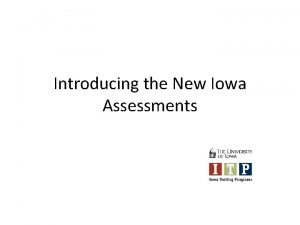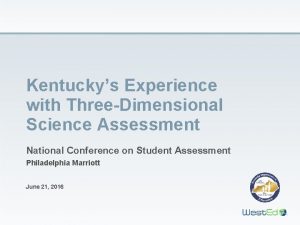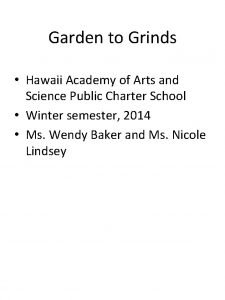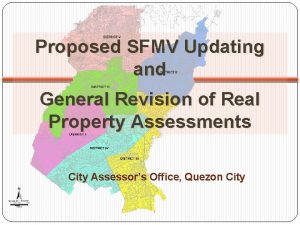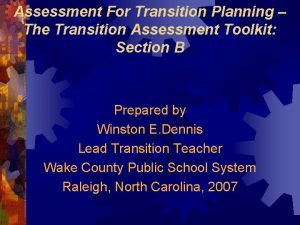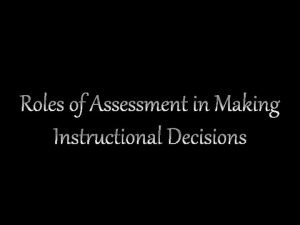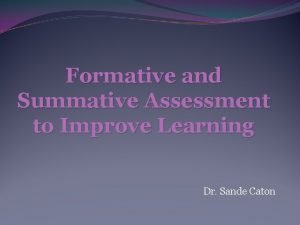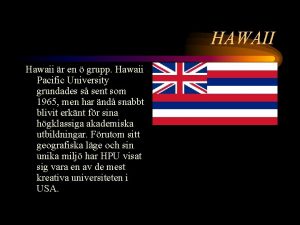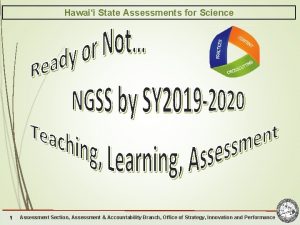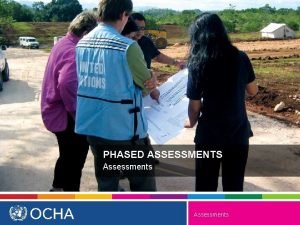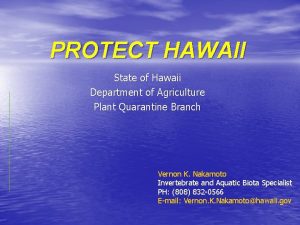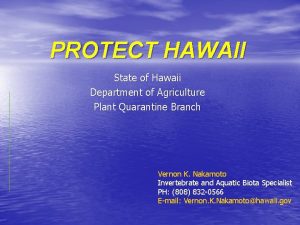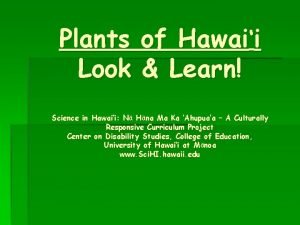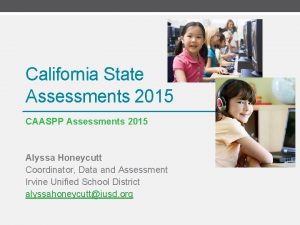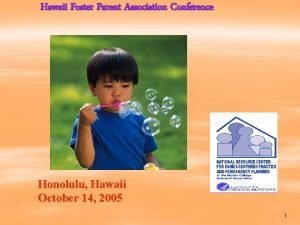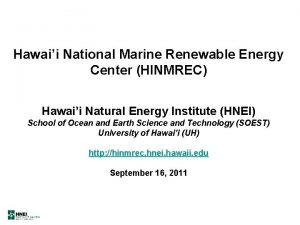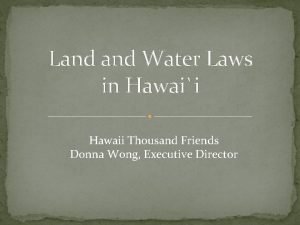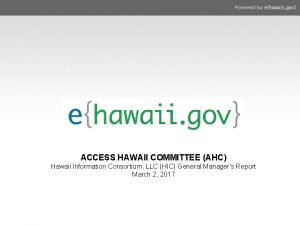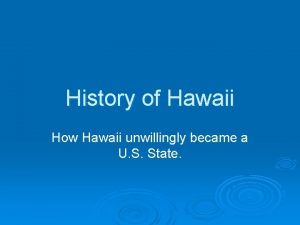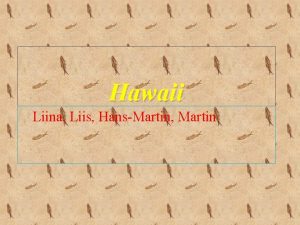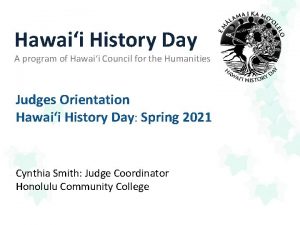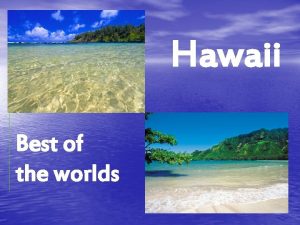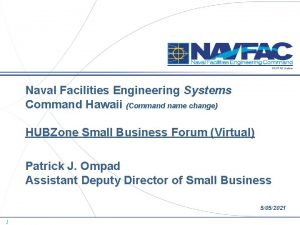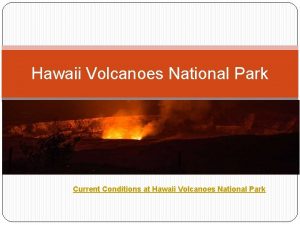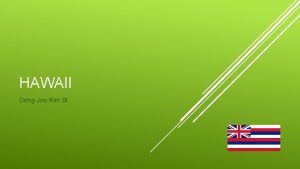Hawaii State Assessments for Science Hawaii Content and











































- Slides: 43

Hawai‘i State Assessments for Science Hawaii Content and Performance Standards (HCPS) III Next Generation Science Standards (NGSS) by SY 2019 -2020 1 Assessment Section, Assessment & Accountability Branch, Office of Strategy, Innovation and Performance n

Why change science standards? ……because the world has changed. ……because what it means to be scientifically literate has changed. Science, engineering and technology have “moved on” in the last 13 years! New research has informed our understanding of how students learn and effective teaching. 2 Assessment Section, Assessment & Accountability Branch, Office of Strategy, Innovation and Performance n

Goals of this Session The Board of Education adopted the NGSS as our state standards in 2016 with full implementation expected by SY 2019 -2020. In this session we will discuss the current status of the transition, explore the NGSS standards, and experience NGSS-based assessment items. This will include: The HSA Bridge Assessments for SY 2017 -18 and 2018 -19. Shifts in teaching and learning as we implement NGSS. Resulting changes in the science assessments beginning in SY 2019 -2020. 3 Assessment Section, Assessment & Accountability Branch, Office of Strategy, Innovation and Performance n

Quick Aside #1: End of Course Exams Biology 1 is currently the only required end of course (EOC)exam. v The Biology EOC is currently based on the HCPS III*. v This EOC serves as the Hawai‘i high school science assessment and required to be taken by all students as they complete Biology 1. Algebra 1 and Algebra 2 EOCs are available to be administered to students completing these courses. These EOCs are optional. v The Alg. 1 and Alg. 2 EOCs are based upon the Hawai‘i Common Core State Standards addressed in the respective courses. The U. S. History EOC is no longer offered. * The Biology EOC is SY 17 -18 and SY 18 -19 is a Bridge Assessment only measuring the HCPS III benchmarks that will be included in the NGSS Assessment beginning in SY 19 -20. 4 Assessment Section, Assessment & Accountability Branch, Office of Strategy, Innovation and Performance n

Quick Aside #2: HSA and Biology EOC Bridge Assessments – WHY? Adoption Feb. 16, 2016 Familiarity Integrating NGSS Practices, Cross-Cutting Concepts, and Engineering in the Classroom Crosswalk and Transition Full implementation SY 2019 -2020 The state is now in the process of implementing the NGSS leading to full implementation by SY 2019 - 2020. Complex areas and schools are at different stages in the process. The Bridge Assessments are intended to provide all students, regardless of the extent to which a school has moved forward with NGSS implementation, with a fair, valid, and reliable test of their science knowledge and skills. 5 Assessment Section, Assessment & Accountability Branch, Office of Strategy, Innovation and Performance n

Often Content is Moving as We Transition 6 Assessment Section, Assessment & Accountability Branch, Office of Strategy, Innovation and Performance n

Revised Blueprints for HCPS III to NGSS Bridge Assessment. Grade 4 Example The content of benchmarks removed appears at a higher or significantly lower grade level in NGSS than in HCPS III. Items related to these benchmarks will no longer appear on the Grade 4 Test 7 Assessment Section, Assessment & Accountability Branch, Office of Strategy, Innovation and Performance n

Quick Aside #2: Bridge Assessments – WHAT? The Bridge Assessments ensure that the performance of students and schools is not negatively impacted by moving forward with implementation of the NGSS. The Bridge Assessments only include items addressing HCPS III benchmarks which align with content that also appears in NGSS at grades 4, middle school earth and space science, and high school life science respectively. These assessments will: v have the same reporting categories and family reports as the current assessments. v be administered at grades 4 and 8 and at the end of Biology 1. v provide grades 4 and 8 students with 2 opportunities to take the Bridge Assessment. v use items from the current HSA and Biology EOC item banks so the look and feel will be like the current assessments. v include NGSS field test items. These items will have no impact on student scores. v be used for SY 2017 -2018 and SY 2018 -2019. 8 Assessment Section, Assessment & Accountability Branch, Office of Strategy, Innovation and Performance n

The Next Generation Science Standards 9 Assessment Section, Assessment & Accountability Branch, Office of Strategy, Innovation and Performance n

The Vision of the NGSS The NGSS emphasizes that science and engineering involve both knowing and doing; that developing rich, conceptual understanding is more productive for future learning than simply memorizing discrete facts. The NGSS describes broad learning goals for students in terms of three dimensions: scientific and engineering practices, crosscutting concepts, and disciplinary core ideas. The NGSS emphasize the importance of providing opportunities for all students through engagement in the practices so that more students and a more diverse group of students will continue their education to become scientists or engineers and, as citizens, will more deeply understand the processes and core ideas of science and engineering. The NGSS describe ambitious targets for student learning in science. These targets are framed as performance expectations that describe how students will use their knowledge as they engage in scientific and engineering practices. 10 Assessment Section, Assessment & Accountability Branch, Office of Strategy, Innovation and Performance n

The Nature of NGSS The NGSS structure science learning around three dimensions: v the practices through which scientists and engineers do their work; v the key crosscutting concepts that link the science disciplines; and v the core ideas of the disciplines of life sciences, physical sciences, earth and space sciences, and engineering and technology. The NGSS describe specific goals for science learning in the form of performance expectations—statements about what students should know and be able to do. The PEs incorporate all three dimensions. The NGSS’s call for “three-dimensional science learning” integrates these dimensions in curriculum, instruction and assessment. Assessment Section, Assessment & Accountability Branch, Office of Strategy, Innovation and Performance n

The Three Dimensions Disciplinary Core Ideas Physical Science Life Science Earth and Space Science Engineering Practices of Science and Engineering 1. Asking Questions and Defining Problems 2. Planning and Carrying Out Investigations 3. Analyzing and Interpreting Data 4. Developing and Using Models 5. Constructing Explanations and Designing Solutions 6. Engaging in Argument from Evidence 7. Using Mathematics and Computational Thinking 8. Obtaining, Evaluating, and Communicating Information 1. 2. 3. 4. 5. 6. 7. Crosscutting Concepts Patterns Cause and Effect: Mechanism and Explanation Scale, Proportion, & Quantity Systems & System Models Energy & Matter: Flows, Cycles, & Conservation Structure & Function Stability & Change Each NGSS student performance expectation integrates two or more dimensions. 12 Assessment Section, Assessment & Accountability Branch, Office of Strategy, Innovation and Performance n

Comparing HCPS and NGSS HCPS III SC. 3. 6. 3 Explain how light traveling in a straight line changes when it reaches an object HCPS III SC. PS. 6. 5 Explain that changes in thermal energy can lead to a phase change of matter 1 -PS 4 -3. Plan and conduct investigations to determine the effect of placing objects made with different materials in the path of a beam of light. MS-PS 1 -4. Develop a model that predicts and describes changes in particle motion, temperature, and state of a pure substance when thermal energy is added or removed. NGSS • Integrates scientific practices, crosscutting concepts, and core ideas • Focuses on deep understanding and application of knowledge • Focuses on readiness for college, career, and citizenship 13 Assessment Section, Assessment & Accountability Branch, Office of Strategy, Innovation and Performance n

A Performance Expectation: HS-LS 4 -2 Biological Evolution: Unity and Diversity Assessment Section, Assessment & Accountability Branch, Office of Strategy, Innovation and Performance 14 n

A Performance Expectation: MS-PS 2 -2 Motion and Stability: Forces and Interactions 15 Assessment Section, Assessment & Accountability Branch, Office of Strategy, Innovation and Performance n

A Performance Expectation: 3 -LS-1 Heredity: Inheritance and Variation of Traits 16 Assessment Section, Assessment & Accountability Branch, Office of Strategy, Innovation and Performance n

Associated Evidence Statements Each of the performance expectations is associated with an evidence statement which further describes what students should know and be able to do. 17 Assessment Section, Assessment & Accountability Branch, Office of Strategy, Innovation and Performance n

Phenomena and NGSS The NGSS require that students not only know science facts but can also apply them to explain phenomena or solve problems using the science and engineering practices. Phenomena are observable events that occur in the universe, in either the natural or the designed world, and that we can use our science knowledge to explain or predict. The goal is to develop ideas, based on evidence, that can explain phenomena. Engineering involves designing solutions to problems that arise from phenomena and/or using explanations of phenomena to design solutions. By centering science education on phenomena, the focus of learning shifts from learning about a topic to figuring out why or how something happens. Students who come to see how science ideas can help explain phenomena related to real world situations learn to appreciate the relevance of science. 18 Assessment Section, Assessment & Accountability Branch, Office of Strategy, Innovation and Performance n

Examples of Phenomena The most powerful phenomena are culturally or personally relevant or consequential to students. An appropriate phenomenon for instruction should help engage all students in working toward the learning goals. v Researchers noticed that, from 1991 to 2003, there was a steady decrease in the chirping of crickets on Kauai. They hadn’t disappeared because crickets were seen everywhere. They discovered that a single mutation on the X chromosome had caused a change in the wing structure of male crickets and they could no longer chirp. Silent crickets were selected for because they could not easily be located by a deadly parasitic fly. (High School) v A handheld device with a crank handle is used to charge a cell phone. Multiple energy transfer/transformations are involved as well as the conservation of energy. (Middle School) v 2 candles are lit on a lab bench. Both are covered at the same time, one with just the candle and another with the candle and a plant inside. Students are to make a prediction about which candle will go out first, and then make observations throughout the demo. (Middle or Elementary School) 19 Assessment Section, Assessment & Accountability Branch, Office of Strategy, Innovation and Performance n

20 Assessment Section, Assessment & Accountability Branch, Office of Strategy, Innovation and Performance n

Instructional Implications of NGSS Question: How do we prepare students to be successful in the 21 st century? Will the lessons taught in school keep them engaged and motivate them to be independent thinkers and lifelong learners? LESS MORE Rote Memorization Science Facts & Concepts Teacher Providing Information Asking Closed Questions Constructing Meaning in Context Science Phenomenon & Modeling Students Investigating & Problem-Solving Answering Open Ended Questions Textbook Work Multiple Sources (Read, Summarize) Cookbook Labs Investigations Driven by Student Questions Worksheets Oversimplification and Exclusion Journals, Posters, & Media Presentations Scaffolding and Equity 21 Assessment Section, Assessment & Accountability Branch, Office of Strategy, Innovation and Performance n

Three Key Points When NGSS is fully implemented: Teachers will need to take advantage of the many resources available to them in their classroom and surroundings! Students will not be “borrowing” knowledge from teachers. They will be learning through exploring and “figuring things out”. Both teachers and students will realize science doesn’t live in a textbook. The bar will be raised for content , for language , and for classroom discourse using strategies that provide equity and access for all students 22 Assessment Section, Assessment & Accountability Branch, Office of Strategy, Innovation and Performance n

Looking at an NGSS Classroom First Steps Towards Transitioning to the NGSS From the Teaching Channel 23 Assessment Section, Assessment & Accountability Branch, Office of Strategy, Innovation and Performance n

Turn & Talk: NGSS Classrooms What will be the biggest changes, greatest challenges, to transforming our science classrooms? In what ways was “student voice” part of the classroom? 24 Assessment Section, Assessment & Accountability Branch, Office of Strategy, Innovation and Performance n

Assessment Implications of NGSS 25 Assessment Section, Assessment & Accountability Branch, Office of Strategy, Innovation and Performance n

NGSS Assessments / Test Items Assessments need to be valid and reliable measures of the knowledge and skills called for in the standards. Since Hawaii’s standards are NGSS, these assessments and the items in them will: be built around phenomena. reflect the NGSS performance expectations, including the clarifying statements and assessment boundaries. be informed by the evidence statements for each PE. include clusters of items measuring all three dimensions. include stand-alone items that measure at least two of the three dimensions. 26 Assessment Section, Assessment & Accountability Branch, Office of Strategy, Innovation and Performance n

Looking at a Grade 4 Cluster (Format has been modified) The Phenomenon 27 Assessment Section, Assessment & Accountability Branch, Office of Strategy, Innovation and Performance n

28 Assessment Section, Assessment & Accountability Branch, Office of Strategy, Innovation and Performance n

29 Assessment Section, Assessment & Accountability Branch, Office of Strategy, Innovation and Performance n

A Middle School Life Science Stand-Alone (Format has been modified) 30 Assessment Section, Assessment & Accountability Branch, Office of Strategy, Innovation and Performance n

31 Assessment Section, Assessment & Accountability Branch, Office of Strategy, Innovation and Performance n

Taking a Look at “NGSS” Items alohahsap. org https: //hsa. alohahsap. org/users/training-sites. stml 32 Assessment Section, Assessment & Accountability Branch, Office of Strategy, Innovation and Performance n

Turn & Talk: NGSS Assessments What are the biggest changes you see as we move from HCPS III to NGSS Assessments How can we best prepare teachers and students for these changes? 33 Assessment Section, Assessment & Accountability Branch, Office of Strategy, Innovation and Performance n

NGSS Summative Assessments The summative assessments are a required component of the assessment system per ESSA. Summative assessments will take place in grades 5 and 8 as well as an end of course (EOC) exam associated with Biology 1 in high school. (This meets U. S. Ed requirement for an assessment in elementary school, middle school, and high school. ) The grades 5 and 8 assessments will be cumulative over grades 3 to 5 and 6 to 8 respectively. The Biology 1 EOC was chosen to align with high school graduation requirements which require all students to successfully complete Biology 1. These assessments will consist of an adaptive set of stand-alone items each of which addresses at least two of the three NGSS dimensions. In addition, students will be presented a set of “item clusters” from across the respective NGSS performance expectations. These clusters will call upon students to demonstrate their knowledge across the three dimensions as applied to natural or designed world phenomena. 34 Assessment Section, Assessment & Accountability Branch, Office of Strategy, Innovation and Performance n

2016 – 2017 Assessment 2017 – 2018 – 2019 – 2020 “Bridge Assessments” HSA Gr 4 Operational NGSS HSA Science and 8 Science and Biology EOC Assessments Gr 5 Bio EOC based on and 8 and Bio HCPS III Field Testing 5, 8, and Bio EOC By Spring 19 In the operational assessment, each student would take an average of 46 items consisting of: 28 items from seven clusters; 12 stand-alone items 6 embedded field test items 35 Assessment Section, Assessment & Accountability Branch, Office of Strategy, Innovation and Performance n

Each student in Grades 5 and 8 will see at least 1 cluster or stand alone item related to the areas: PS 1 Matter and Its Interactions PS 2 Motion and Stability: Forces and Interactions PS 3 Energy PS 4 Waves and their Applications in Technologies for Information Transfer LS 1 From Molecules to Organisms: Structures and Processes LS 2 Ecosystems: Interactions, Energy, and Dynamics LS 3 Heredity: Inheritance and Variation of Traits LS 4 Unity and Diversity ESS 1 Earth’s Place in the Universe ESS 2 Earth’s Systems ESS 3 Earth and Human Activity The Biology EOC will include LS 1, LS 2, LS 3, LS 4, and a limited amount of items from ESS where PEs specifically intersect with living things 36 Assessment Section, Assessment & Accountability Branch, Office of Strategy, Innovation and Performance n

Universal Tools, Designated Supports, and Accommodations Tools and resources will be similar to those currently available on the HSA science and Smarter Balanced mathematics assessments and will ensure that each and every student has the appropriate universal tools, designated supports, and accommodations. These accommodations will include Braille and American Sign Language. Item Sharing Hawaii will be sharing items (stand-alones and item clusters) with CT, ID, OR, RI, WV, WY, UT, VI, VT, and perhaps other states. 37 Assessment Section, Assessment & Accountability Branch, Office of Strategy, Innovation and Performance n

HIDOE NGSS Reporting: Grades 5 and 8 Overall claim: (For each claim there will be an overall scale score with performance level descriptors for individual students. ) (“Language related to” a student’s application of the science and engineering practices will be included in the performance level descriptors associated with the overall and claim scores. ) The student applies an understanding of the disciplinary core ideas of science and uses the science and engineering practices and crosscutting concepts to explain phenomena and design solutions to problems in the natural and the designed world. Yields an overall scale score for Science for individual students 1. Living Systems: The student applies an understanding of the disciplinary core ideas of the life sciences and uses science and engineering practices as well as crosscutting concepts to explain phenomena in living systems. T F A R D 2. Physical Systems: The student applies an understanding of the disciplinary core ideas of physical sciences and uses science and engineering practices as well as crosscutting concepts to explain phenomena in physical systems. 3. Earth and Space Systems: The student applies an understanding of the disciplinary core ideas of the earth and space sciences and uses science and engineering practices as well as crosscutting concepts to explain phenomena in Earth and space systems TBD>> Reporting related to Engineering. ETS 1 Engineering Design Assessment Section, Assessment & Accountability Branch, Office of Strategy, Innovation and Performance n

HIDOE NGSS Reporting: Biology EOC Overall claim: (For each claim there will be an overall scale score with performance level descriptors for individual students. ) (“Language related to” a student’s application of the science and engineering practices will be included in the performance level descriptors associated with the overall and claim scores. ) T F A R D The student applies an understanding of the disciplinary core ideas of the life sciences (at the high school level) and uses the science and engineering practices as well as crosscutting concepts to explain phenomena and design solutions to problems in the natural and the designed world. Yields an overall scale score for the Biology End of Course Exam 1. Molecules and Organisms: Structures and Processes: The student applies an understanding of the disciplinary core ideas of structures and processes within the life sciences and uses science and engineering practices as well as crosscutting concepts to explain phenomena in molecules and organisms structures and processes. 2. Ecosystems: Interactions, Energy, and Dynamics: The student applies an understanding of the disciplinary core ideas of interactions, energy, and dynamics within the life sciences and uses science and engineering practices as well as crosscutting concepts to explain phenomena in ecosystem interactions, energy, and dynamics. 3. Heredity: Inheritance and Variation of Traits: The student applies an understanding of the disciplinary core ideas of inheritance and variation of traits within the life sciences and uses science and engineering practices as well as crosscutting concepts to explain phenomena in inheritance and variation of traits. 4. Biological Evolution: Unity and Diversity: The student applies an understanding of the disciplinary core ideas of unity and diversity within the life sciences and uses science and engineering practices as well as crosscutting concepts to explain phenomena in biological unity and diversity. TBD>> Reporting related to Engineering. ETS 1 Engineering Design Assessment Section, Assessment & Accountability Branch, Office of Strategy, Innovation and Performance n

Additional Reporting at Class, School, Complex, and State Levels. Performance Expectations PEs will be treated as a parallel to the “targets” in SB and reports would be available similar to the target reports for SB assessments. Each applicable PE will be reported with an indication of performance relative to proficiency as: above, near, below. Science and Engineering Practices, either individually or grouped in three areas (see below), will be treated in a manner similar to the PEs. SEP in three sub-areas: Gathering F A R D (Asking Questions and Defining Problems; Planning and Carrying Out Investigations) Reasoning (Analyzing and Interpreting Data; Using Mathematics and Computational Thinking; Constructing Explanations and Designing Solutions; Engaging in Argument from Evidence) Communicating (Developing and Using Models; Obtaining, Evaluating, and Communicating Information) Assessment Section, Assessment & Accountability Branch, Office of Strategy, Innovation and Performance n

The Hawaii “Ultimate” NGSS Assessment System (Adapted, in part, from drafts developed by the CCSSO Science SCASS incorporating some recommendations from the NRC Board on Testing and Assessment (BOTA)) T F A R D The NGSS the assessment system should eventually include: Summative assessments for accountability and to inform improvement (Administered at grades 5, 8, and Biology). Short, optional, “secure” assessments to monitor learning and inform teaching in the “none tested” grades (3, 4, 6, and 7). Tasks and tools for classroom assessments for “local use” to monitor student progress and provide feedback to improve student learning. Classroom formative assessment resources and tools similar to the Smarter Balanced Digital Library. The extent to which the “ultimate NGSS assessment system” is developed will depend upon: Needs identified by HIDOE at various levels from the state office to complex areas and schools. Available resources including shared development, leveraging resources, and partnerships. Teachers and “qualified” community members will be involved throughout the process including review of item specs and item development. Assessment Section, Assessment & Accountability Branch, Office of Strategy, Innovation and Performance n

NGSS Resources alohahsap. org/HSA/ www. nextgenscience. org http: //ngss. nsta. org/ www. ambitiousscienceteaching. org www. nextgenstorylines. org www. stemteachingtools. org www. ngsspln. com www. teachingchannel. org http: //www. csai-online. org/spotlight/science-assessment-itemcollaborative 42 Assessment Section, Assessment & Accountability Branch, Office of Strategy, Innovation and Performance n

Critical Take-Aways Moving Forward HSA science tests for SYs 2017 -2018 and 2018 -2019 will be Bridge Assessments in grades 4, 8 and the Biology 1 EOC. (Students in grades 4 and 8 will have 2 opportunities. ) Over the next two years schools will continue to transition to phenomena-based NGSS teaching and learning including disciplinary core ideas, science and engineering practices, and cross-cutting concepts. The bar will be raised for content, for language, and for classroom discourse using strategies that provide equity and access for all students. NGSS operational assessments will begin in SY 2019 -2020 with: v Tests will be grades 5, 8, and the Biology EOC. v The grades 5 and 8 tests will cover the set of upper elementary (grades 35) and middle school performance expectations respectively. v NGSS assessments will consist of stand-alone items as well as “more complex” item clusters built around phenomena. 43 Assessment Section, Assessment & Accountability Branch, Office of Strategy, Innovation and Performance n
 Iowa staewide assessment of student progress
Iowa staewide assessment of student progress Kentucky assessments science
Kentucky assessments science Characteristics of esp
Characteristics of esp Hawaii academy of arts and sciences
Hawaii academy of arts and sciences Static content vs dynamic content
Static content vs dynamic content Science is my favorite subject because
Science is my favorite subject because Hawaii state assessment
Hawaii state assessment General revision of assessments and property classification
General revision of assessments and property classification Informal and formal assessment
Informal and formal assessment Informal reading assessments
Informal reading assessments Diagnostic summative and formative assessment
Diagnostic summative and formative assessment Physical fitness components and tests grade 9
Physical fitness components and tests grade 9 Penilaian formatif
Penilaian formatif Kontinuitetshantering
Kontinuitetshantering Typiska novell drag
Typiska novell drag Tack för att ni lyssnade bild
Tack för att ni lyssnade bild Vad står k.r.å.k.a.n för
Vad står k.r.å.k.a.n för Varför kallas perioden 1918-1939 för mellankrigstiden?
Varför kallas perioden 1918-1939 för mellankrigstiden? En lathund för arbete med kontinuitetshantering
En lathund för arbete med kontinuitetshantering Underlag för särskild löneskatt på pensionskostnader
Underlag för särskild löneskatt på pensionskostnader Tidbok för yrkesförare
Tidbok för yrkesförare Sura för anatom
Sura för anatom Densitet vatten
Densitet vatten Datorkunskap för nybörjare
Datorkunskap för nybörjare Stig kerman
Stig kerman Hur skriver man en debattartikel
Hur skriver man en debattartikel Delegerande ledarskap
Delegerande ledarskap Nyckelkompetenser för livslångt lärande
Nyckelkompetenser för livslångt lärande Påbyggnader för flakfordon
Påbyggnader för flakfordon Lufttryck formel
Lufttryck formel Svenskt ramverk för digital samverkan
Svenskt ramverk för digital samverkan Urban torhamn
Urban torhamn Presentera för publik crossboss
Presentera för publik crossboss Argument för teckenspråk som minoritetsspråk
Argument för teckenspråk som minoritetsspråk Bat mitza
Bat mitza Klassificeringsstruktur för kommunala verksamheter
Klassificeringsstruktur för kommunala verksamheter Epiteltyper
Epiteltyper Bästa kameran för astrofoto
Bästa kameran för astrofoto Centrum för kunskap och säkerhet
Centrum för kunskap och säkerhet Byggprocessen steg för steg
Byggprocessen steg för steg Bra mat för unga idrottare
Bra mat för unga idrottare Verktyg för automatisering av utbetalningar
Verktyg för automatisering av utbetalningar Rutin för avvikelsehantering
Rutin för avvikelsehantering Smärtskolan kunskap för livet
Smärtskolan kunskap för livet
